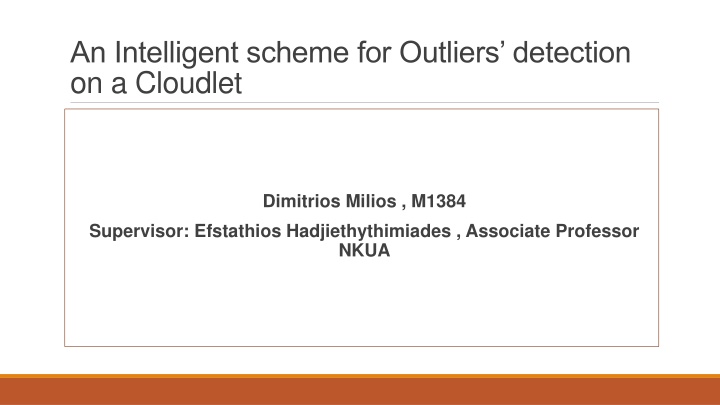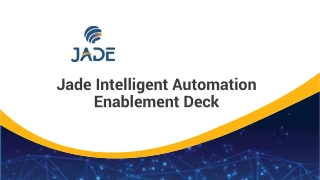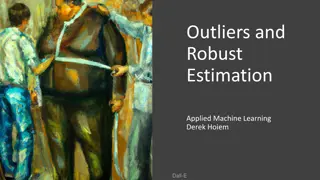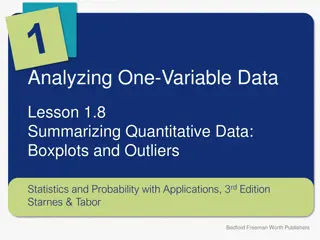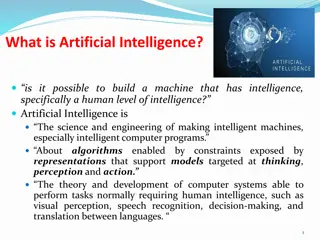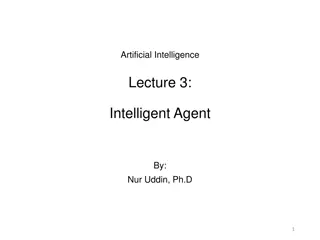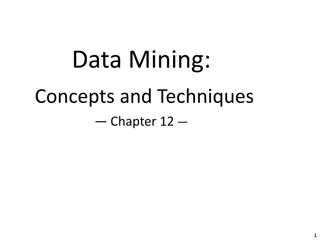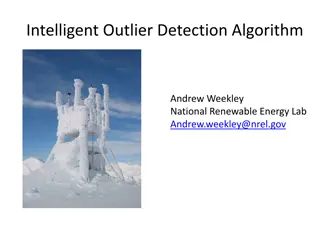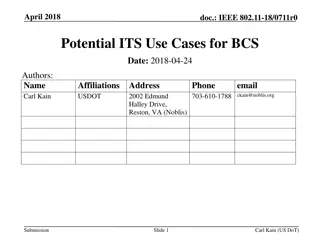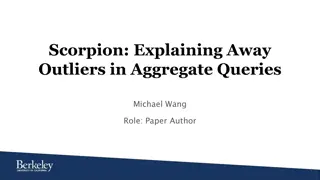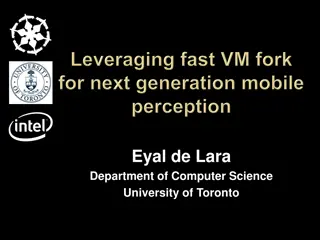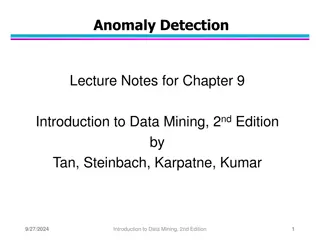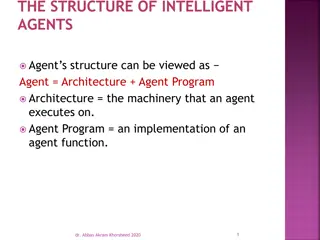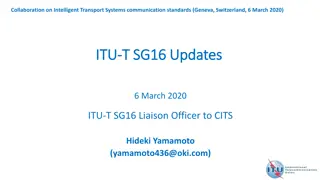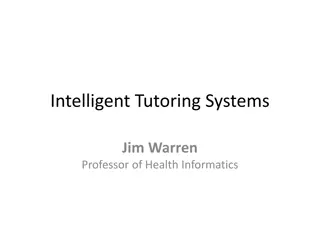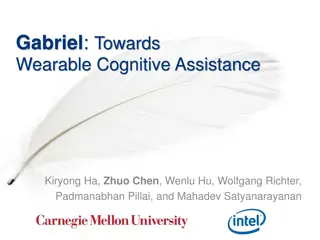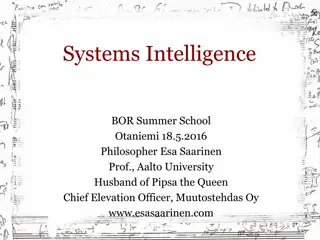Intelligent Outliers Detection on Cloudlets
A scheme for outliers detection on cloudlets using PCA dimension reduction and variance analysis. Explore cloud computing, mobile cloud computing, cloudlet architecture, and models. Gain insights into features like scalability, on-demand services, and quality of service in cloud computing. Learn about the mobile cloud computing infrastructure and models.
Download Presentation

Please find below an Image/Link to download the presentation.
The content on the website is provided AS IS for your information and personal use only. It may not be sold, licensed, or shared on other websites without obtaining consent from the author.If you encounter any issues during the download, it is possible that the publisher has removed the file from their server.
You are allowed to download the files provided on this website for personal or commercial use, subject to the condition that they are used lawfully. All files are the property of their respective owners.
The content on the website is provided AS IS for your information and personal use only. It may not be sold, licensed, or shared on other websites without obtaining consent from the author.
E N D
Presentation Transcript
An Intelligent scheme for Outliers detection on a Cloudlet Dimitrios Milios , M1384 Supervisor: Efstathios Hadjiethythimiades , Associate Professor NKUA
Thesis Outline Cloud Computing Mobile Cloud Computing Cloudlet and Cooperative caching Hilout with temporal approach for detection of Outliers PCA dimension reduction Variance per dimension CloudSim simulation framework ,Experiments and results Conclusions
Cloud Computing : Definition Cloud Computing is : a framework for sharing resources, information and software capabilities to different mobile devices. a service where the resources will be available on the Cloud and can be shared by the devices on demand. a model for enabling convenient, on-demand network access to Computing resources that can be rapidly provisioned and released with minimal management effort.
Cloud Computing : Features Scalability and On-Demand Services Quality of Service (QoS) User-Centric Interface Autonomous System Pricing Cloud
Mobile Cloud Computing (MCC) : Definition Mobile Cloud Computing : refers to an infrastructure where both the data storage and data processing happen outside of the mobile device. can be defined as a combination of mobile web and Cloud Computing, which is the most popular tool for mobile users to access applications and services on the Internet. can be expressed by the Cloudlet concept : the mobile device offloads its workload to a local Cloudlet comprised of several multi-core computers with connectivity to the remote Cloud servers.
Mobile Cloud Computing : Models Client Model: mobile device act as client and mobile user access service is offered by Cloud by thin layer of interface web browser. Client / Cloud Model: the concept of task partitioning comes in which mobile users give a part of task to Cloud for processing. Cloud Model: mobile device itself is the part of Cloud. One or more mobile devices create the structure of Cloud.
Mobile Cloud Computing : Major Features - Advantages Flexibility/Elasticity Scalability of Infrastructure Broad Network Access Location Independence Reliability Decrease WAN latency Storage , computing and power resource of mobiles
Mobile Cloud Computing : Challenges(1/2) Low Bandwidth Security and Privacy in the Cloud Prone to Attack Dependency and Vendor Lock-In Limited Control and Flexibility Increased Vulnerability Loss of connection Bandwidth/Latency Limited resources
Mobile Cloud Computing : Challenges (2/2) Recommended solutions for the challenges are given regarding : Privacy and Confidentiality Data Integrity Data Location and Relocation Data Availability Not sufficient solutions are not given yet regarding : Supporting continuous mobility while ensuring connectivity to the Cloud Security in Mobile Clouds Incentives for surrogates
Cloudlet : Definition and Architecture Cloudlet: is a computer or a cluster of computers connected at the edge of the network to provide low-latency access to Computing resources for mobile devices. Cloudlet architecture : Cloudlet is considered as the middle tier of a 3- tier hierarchy: mobile device, Cloudlet and Cloud.
Cloudlet : Infrastructure types VM based approach : A mobile user exploits virtual machine (VM) technology to rapidly instantiate customized service software on a nearby Cloudlet and then uses that service over a wireless LAN, the mobile device typically functions as a thin client with respect to the service. A Cloudlet is a trusted, resource-rich computer or cluster of computers that s well- connected to the Internet and available for use by nearby mobile devices. Dynamic VM synthesis : A mobile device delivers a small VM overlay to the Cloudlet infrastructure that already possesses the base VM from which this overlay was derived. The infrastructure applies the overlay to the base to derive the launch VM, which starts executing in the precise state in which it was suspended.
Cloudlet : Models and Challenges Cloudlet Models : ad hoc Cloudlet elastic Cloudlet Cloudlet Challenges : remains dependent on service providers to actually deploy such Cloudlet infrastructure in LAN networks . Recommended solution : a more dynamic Cloudlet concept is proposed , where all devices in the LAN network can cooperate in the Cloudlet the coarse granularity of VMs as unit of distribution. Recommended solution : better performance can be achieved by dynamically partitioning the application in components. resources in the Cloudlet still limited . Recommended solution : component offloading, a more flexible allocation of the Cloudlet resources is possible, so that priority is given for latency-critical parts of the application, while non real-time parts can be offloaded to a more distant Cloud.
Cooperative Caching Definition : is based on the idea of demanding the necessary data from a neighbor node in the network instead of the original resource. different approaches have been proposed for cooperative caching, such as, caching on mobile nodes, caching on intermediate or proxy nodes or caching on the edge of network. in Mobile Cooperative Caching, mobile devices try to form an ad hoc network with other mobile nodes in the proximity to share the relevant data. Advantages : Cooperative caching improves the response time by reducing VM synthesis time by caching the previous state. Distributed caches permits a system to deal with concurrent client request as well as sharing contents. Data caching increases battery life in mobile devices by reducing wireless communication.
Cloudlet Scenario : Detection of Outliers (1/2) Use of CloudSim simulation framework Cloudlet : is considered as a repository : a MySQL schema table Input : data-vectors , data from IoT devices, with values : multiple dimensions- coordinates. They arrive sequentially. Hilout Algorithm decides if an incoming vector is outlier or not. If it is , it is marked as such and it stored in the repository.
Hilout Algorithm Original Hilout Algorithm : Hilout finds distance-based Outliers, but uses the ranks of distance instead of the absolute distance in outlier detection. The weight of object o is defined as: Hilout Algorithm with temporal approach : Not only the spatial proximity with the neighbors is taken into account for the decision but also the temporal proximity. If the neighbors' timestamps are not within a time window W, an extra penalty is added to the weight of each of the neighbors-vectors accordingly.
Hilout Algorithm : Steps A new data-vector wants to enter the cloudlet The number of neighbors is decided. The number of the neighbors(k) is randomized between the half and the total number of vectors of the current dataset that is stored in the repository. We find the neighbors according to the proximity of them comparing to the input vector's position, as the Hilout algorithm defines. If the weight of the incoming vector is the highest, then it is marked as an outlier and is stored in the repository with weight 0. If it is not an outlier, then the weights of the neighbors are updated (plus the relative distance with the incoming vector) and the incoming vector is stored.
Hilout Algorithm : Calculation of weight When the incoming vector arrives to the Cloudlet, the timestamp of it minus 1 millisecond becomes the time window (W) If the timestamp of each neighbor is out of range of the W, then a penalty is added to its weight. There is no penalty for the incoming vector because its timestamp is one of the edges of the W. The weight of the incoming vector is only the sum of the relative distance with its neighbors but the weight of the neighbors is the sum, relative distance with the incoming vector is not taken into account, plus the possible penalty due to the time window.
Input Data The input data, follow the Gaussian distribution. Each dimension's value is given, in the code, by the formula: mean * randomNumber * deviation. the randomNumber is given by the Random number generator of Java The deviation is set from the set {5,25,50} For every 10 data vectors that are inserted, Outliers or not, the mean deviates by a value that is given by the Exponential distribution. The deviation's is given, in the code, by the formula: (log (1- randomNumber)) / (-lambda). The lambda is set from the set {0.2,5}, the randomNumber is given by the Random number generator of Java and it must be double type and the log is the logarithm with base e.
PCA dimension reduction Principal component analysis (PCA) is the main linear technique for dimension reduction. It reduces the data down into its basic components, stripping away any unnecessary parts. It actually finds the principal components of data. So what are principal components then? They re the underlying structure in the data. They are the directions where there is the most variance, the directions where the data is most spread out.
Hilout with PCA : Steps A new data-vector wants to enter the cloudlet The number of neighbors is decided. The number of the neighbors(k) is randomized between the half and the total number of vectors of the current dataset that is stored in the repository. We find the neighbors according to the proximity of them comparing to the input vector's position, as the Hilout algorithm defines .The difference this time is that we apply the PCA method on all the records, which are not Outliers, of the dataset, expect the incoming vector, and we find the principal components of the dataset. Decision if it is an outlier is taken : If the weight of the incoming vector is the highest, then it is marked as an outlier and is stored in the repository with weight 0. If it is not an outlier, then the weights of the neighbors are updated (plus the relative distance with the incoming vector) and the incoming vector is stored.
PCA : example Records : 1st record: {96.93,95.04,96.15,99.04} 2nd record: {93.94,106.34,101.99,94.39} 3rd record: {92.98,96.68,101.29,103.75} 4th record: {108.43,92.9,94.11,92.56} PCA Components : PCA1 PCA2 PCA3 PCA4 dim1: [[-0.50, -0.50, -0.50, -0.50], dim2: [0.86, -0.36, -0.29, -0.21], dim3: [0.09, 0.64, 0.04, -0.77], dim4: [-0.01, -0.47, 0.81, -0.35]]
Variance per Dimension Another characteristic we study in this Thesis is the Variance per dimension. Variance (commonly denoted 2) is a very useful measure of the relative amount of scattering of a given set. In other words, knowing the Variance can give you an idea of how closely the values in a set cluster around the mean.
Goals of our scheme Goals : how the number of the data vectors affects the number of Outliers that are detected how the number of the dimensions affects the number of Outliers that are detected how the deviation of the mean in the Gaussian distribution affects the number of Outliers that are detected how the lambda parameter in the Exponential distribution affects the number of Outliers that are detected
Why we chose this scheme Hilout Algorithm : has been designed to efficiently detect the top n Outliers Cloudlet : the centralized nature of the Cloudlet repository has advantages such as : Data Integrity Cost effectiveness Increased efficiency Enhanced data quality Changeability Accessibility
CloudSim Framework CloudSim framework is a programming tool designed to normalize and accelerate the process of conducting experimental studies using Cloud Computing environments. By using CloudSim, researchers and industry-based developers can focus on specific system design issues that they want to investigate, without getting concerned about the low level details related to Cloud-based infrastructures and services. Important classes that are provided : Cloudlet , Host , DataCenter etc. In our experiments we have only one configuration: a datacenter with one host and run one Cloudlet on it.
Experiments Configurations 2 cases : Hilout with temporal approach Hilout with temporal approach with PCA Vectors Dimensions Deviation Lambda 50,100,500,1000 50,100,500,1000 2 - 10 2 - 10 5 5 0.2 5 50,100,500,1000 50,100,500,1000 50,100,500,1000 50,100,500,1000 2 - 10 2 - 10 2 - 10 2 - 10 25 25 50 50 0.2 5 0.2 5
Variance per dimension : Results Deviation : 5 , lambda:0.2 Deviation : 5 , lambda:5 Deviation : 25 , lambda:0.2 Deviation : 25 , lambda:5 Deviation : 50 , lambda:0.2 Deviation : 50 , lambda:5
Conclusions We saw the concepts of Cloud Computing, Mobile Cloud Computing We saw the concepts of a Cloudlet and of Cooperative Caching We presented an intelligent scheme for detecting Outliers on a Cloudlet simulation environment by using Hilout Algorithm with a temporal approach We saw the definition of PCA dimension reduction We presented the results of the experiments we did. We had 2 main cases: Hilout applied without PCA, Hilout applied with PCA. The results showed that the most important factor is the deviation parameter and more Outliers are detected on average while it increases. The case with PCA gave more or less similar results with the simple case. In our results we provided also the Variance per dimension in order to provide some statistical conclusions regarding the different configurations.
Thank you !!! Questions ?
